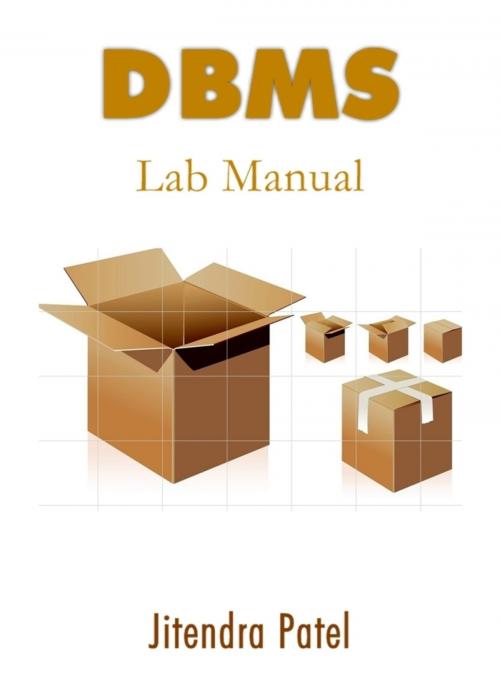| Author: | Jitendra Patel | ISBN: | 9781300485452 |
| Publisher: | ebookit | Publication: | December 30, 2012 |
| Imprint: | eBookIt.com | Language: | English |
| Author: | Jitendra Patel |
| ISBN: | 9781300485452 |
| Publisher: | ebookit |
| Publication: | December 30, 2012 |
| Imprint: | eBookIt.com |
| Language: | English |
DBMS LAB MANUAL
The Structured Query Language (SQL) is a computer language for accessing and manipulating databases.
The fundamental concept is to think of the data as being stored in one or more tables. When a request is made to retrieve data from these tables, which is called a "query", the resultant output is also presented in as table.
There are many different versions of the SQL language, but to be in compliance with the ANSI SQL '92 Standard, they must use and support the same major keywords in a similar manner (such as SELECT, UPDATE, DELETE, INSERT, WHERE, and others.
This manual is specially written for Students who are interested in understanding Structured Query Language and PL-SQL concepts in the Computer Engineering and Information technology field and wants to gain enhance knowledge about power of SQL Language in Relational Database Management System Development.
The manual covers practical point of view in all aspects of SQL and PL/SQL including DDL, DML,DCL sublanguages, also there are practices for Views, Group by, Having Clause. All PL-SQL concepts like Condition and Loop Structures, Functions and Procedures, Cursor, Triggers, Locks are illustrated using best examples.
The Structured Query Language (SQL) is a computer language for accessing and manipulating databases.
The fundamental concept is to think of the data as being stored in one or more tables. When a request is made to retrieve data from these tables, which is called a "query", the resultant output is also presented in as table.
There are many different versions of the SQL language, but to be in compliance with the ANSI SQL '92 Standard, they must use and support the same major keywords in a similar manner (such as SELECT, UPDATE, DELETE, INSERT, WHERE, and others.
This manual is specially written for Students who are interested in understanding Structured Query Language and PL-SQL concepts in the Computer Engineering and Information technology field and wants to gain enhance knowledge about power of SQL Language in Relational Database Management System Development.
The manual covers practical point of view in all aspects of SQL and PL/SQL including DDL, DML,DCL sublanguages, also there are practices for Views, Group by, Having Clause. All PL-SQL concepts like Condition and Loop Structures, Functions and Procedures, Cursor, Triggers, Locks are illustrated using best examples.
DBMS LAB MANUAL
The Structured Query Language (SQL) is a computer language for accessing and manipulating databases.
The fundamental concept is to think of the data as being stored in one or more tables. When a request is made to retrieve data from these tables, which is called a "query", the resultant output is also presented in as table.
There are many different versions of the SQL language, but to be in compliance with the ANSI SQL '92 Standard, they must use and support the same major keywords in a similar manner (such as SELECT, UPDATE, DELETE, INSERT, WHERE, and others.
This manual is specially written for Students who are interested in understanding Structured Query Language and PL-SQL concepts in the Computer Engineering and Information technology field and wants to gain enhance knowledge about power of SQL Language in Relational Database Management System Development.
The manual covers practical point of view in all aspects of SQL and PL/SQL including DDL, DML,DCL sublanguages, also there are practices for Views, Group by, Having Clause. All PL-SQL concepts like Condition and Loop Structures, Functions and Procedures, Cursor, Triggers, Locks are illustrated using best examples.
The Structured Query Language (SQL) is a computer language for accessing and manipulating databases.
The fundamental concept is to think of the data as being stored in one or more tables. When a request is made to retrieve data from these tables, which is called a "query", the resultant output is also presented in as table.
There are many different versions of the SQL language, but to be in compliance with the ANSI SQL '92 Standard, they must use and support the same major keywords in a similar manner (such as SELECT, UPDATE, DELETE, INSERT, WHERE, and others.
This manual is specially written for Students who are interested in understanding Structured Query Language and PL-SQL concepts in the Computer Engineering and Information technology field and wants to gain enhance knowledge about power of SQL Language in Relational Database Management System Development.
The manual covers practical point of view in all aspects of SQL and PL/SQL including DDL, DML,DCL sublanguages, also there are practices for Views, Group by, Having Clause. All PL-SQL concepts like Condition and Loop Structures, Functions and Procedures, Cursor, Triggers, Locks are illustrated using best examples.















